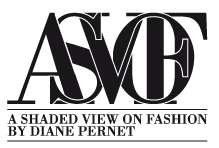Dear Diane and Shaded Viewers,
As you may have seen on the ASVOF instagram and facebook, this week we’ve been in beautiful Florence for the occasion of IFFTI 2015 – the annual conference exploring ideas and methodologies on fashion and education, hosted this year by Polimoda and curated by Linda Loppa. It involves the work of 26 installations, performances and projections, as well as a film competition run with ASVOF, paper submissions and some wonderful special guests.
Yesterday was the first event of the ‘In Conversation With…’ series where a group of specialists discussed the body, the human and language, and the potential here to re-work and re-teach fashion. What was most compelling were the particular specialities of each panellist, as Clemens Thornquist said we need to ‘concentrate on our core competences and then form partnerships.’ That’s exactly what happened here. Whilst it might seem unlikely to place the smell guru and professional ‘in-betweener’, Sissel Tolaas, for example, in a discussion on fashion education, her charm and enlivening comments about how we’re able to re-train our perception of smell beyond a ‘yes-no’ answer set the precedent that fashion education has space to expand beyond it’s set of norms.
Indeed Tim Blanks mentioned the lack of critical tradition in fashion as a normative challenge to overcome, as compared to every other creative field like film and theatre with their strong canon of writing that’s built sophisticated criteria for judgement, in fashion, writing is ‘not particularly sophisticated, but it’s enthusiastic.’
Blanks’ genuine optimism stood out against others’ thoughts on the anaemic language of fashion that necessitates the construction of new words. An ontological revival, if you will, suggested by the work of Thornquist and Danilo Venturi. Thornquist’s approach to fashion education is in finding the core; the body as the core of design, and words as the core of conversation. Venturi de- and re-constructs words to find their essential nature, and believes that both students and teachers should be authors of these new words, ‘not authorised or unauthorised, just authors.' But it was Blanks in the end who was uncomplicated in his opposition, “there are so many words that already exist that we don't use, or don't know how to use. Why stress ourselves with trying to create new words?”
In any case, everyone agreed that a sophisticated use of words is imperative. And in fact the word ‘fashion’, according to Linda Loppa, is not going to make the cut. This echoes the idea of returning to essentials. Taking moments away from screens and using our hands to do more than press buttons, is essential. Craft, books, words, the body; all these ideas are essentialist, romantic, and inviting. As Gary Needham spoke of the loss of materiality, ‘I like digital when it's democratic but perhaps it's the enemy of the senses.'
‘Why don't we speak about the smell of a dress, or the smell of the person who wears the dress?’, asked Tolaas. ‘- or the sound?!, Blanks pointed out.
These ideas reverberated beyond the conference and emerged in some of the more striking of the 26 installations. The performance of Daniele Davitti commented on the oversaturation of information and unnecessary words, with his Silent Interview. And Adjust, the experimental piece by Adele Varcoe where she and other performers carefully changed small styling details of the public, like the length of a cuff by only one centimetre, showing the bizarrely intimate and intrusive nature of non-verbal communication, and moreover the unnoticed importance placed on the sartorial expression of our identity.
The body’s senses are essential, of course, and this is made all the more clear when they’re deprived or reprioritised. Needham’s performance in collaboration with Yvonne Trew had him standing in the rotunda of the National Library, reading an essay whilst wearing a Gimp Mask. The Fetish Moment is a deprivation of our ability to see his identity – or the deprivation of gaze – and was as unnerving as it was fascinating to see in this grand old space. In another moment, Gianpaolo D’Amico’s installation The Echo in her Heart saw six models standing still in a corridor in the basement of Santa Croce with their individual heart-beats amplified in real time. In this case, the identity of each model and her emotions were being told without words, involuntarily, and beautifully through sound.
Stefan Siegel’s widely admired work with Not Just a Label came into the spotlight in this conversation, as indeed it works by embracing the screen, and in a sense, neglecting the tactile. Though the dichotomy lays here as he works closely with young designers to ‘empower the artisan’ through creating a space of visibility and interaction. This highlighted the mutual aim of the panel to ‘humanise the fashion industry’. And the large scale magazine-come-installation displayed in Villa Favard, HUMAZINE, by Aki Choklat and Ruggero Mengoni powerfully displayed this idea with charm and ceremony. Siegel said, ‘it’s about widening your perspective. Today your students have more followers than magazines print copies. We should stop wishing away the world that we have created…’
This quickly made me think of the wonderful long-term utopic and anarchic Bishan Project by Chinese artist and activist, Ou Ning, which is really about positive essentialism and optimism – though more on that tomorrow.
Lastly, Tolaas commented, ‘we need passion and enthusiasm! Play! Joy!’
Absolutely.
Happy Friday,
Sophie

![]()



